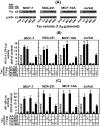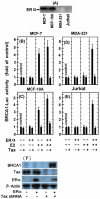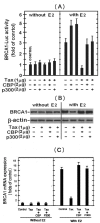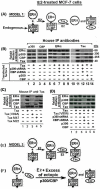HTLV-1 Tax oncoprotein inhibits the estrogen-induced-ER α-Mediated BRCA1 expression by interaction with CBP/p300 cofactors
- PMID: 24586743
- PMCID: PMC3931753
- DOI: 10.1371/journal.pone.0089390
HTLV-1 Tax oncoprotein inhibits the estrogen-induced-ER α-Mediated BRCA1 expression by interaction with CBP/p300 cofactors
Abstract
BRCA1 is a multifunctional tumor suppressor, whose expression is activated by the estrogen (E2)-liganded ERα receptor and regulated by certain recruited transcriptional co-activators. Interference with BRCA1 expression and/or functions leads to high risk of breast or/and ovarian cancer. Another multifunctional protein, HTLV-1Tax oncoprotein, is widely regarded as crucial for developing adult T-cell leukemia and other clinical disorders. Tax profile reveals that it can antagonize BRCA1 expression and/or functionality. Therefore, we hypothesize that Tax expression in breast cells can sensitize them to malignant transformation by environmental carcinogens. Here we examined Tax effect on BRCA1 expression by testing its influence on E2-induced expression of BRCA1 promoter-driven luciferase reporter (BRCA1-Luc). We found that E2 strongly stimulated this reporter expression by liganding to ERα, which consequently associated with BRCA1 promoter, while ERα concomitantly recruited CBP/p300 to this complex for co-operative enhancement of BRCA1 expression. Introducing Tax into these cells strongly blocked this E2-ERα-mediated activation of BRCA1 expression. We noted, also, that Tax exerted this inhibition by binding to CBP/p300 without releasing them from their complex with ERα. Chip assay revealed that the binding of Tax to the CBP/p300-ERα complex, prevented its link to AP1 site. Interestingly, we noted that elevating the intracellular pool of CBP or p300 to excessive levels dramatically reduced the Tax-mediated inhibition of BRCA1 expression. Exploring the mechanism of this reduction revealed that the excessive co-factors were sufficient to bind separately the free Tax molecules, thus lowering their amount in the CBP/p300-ERα complex and relieving, thereby, the inhibition of BRCA1 expression.
Conflict of interest statement
Figures






Similar articles
-
Effect of TPA and HTLV-1 Tax on BRCA1 and ERE controlled genes expression.Cell Cycle. 2017 Jul 18;16(14):1336-1344. doi: 10.1080/15384101.2017.1327491. Epub 2017 Jun 8. Cell Cycle. 2017. PMID: 28594273 Free PMC article.
-
Differential effects of HTLV-1 Tax oncoprotein on the different estrogen-induced-ER α-mediated transcriptional activities.Cell Cycle. 2016 Oct;15(19):2626-2635. doi: 10.1080/15384101.2016.1208871. Epub 2016 Jul 15. Cell Cycle. 2016. PMID: 27420286 Free PMC article.
-
Molecular characterization of HTLV-1 Tax interaction with the KIX domain of CBP/p300.J Mol Biol. 2007 Sep 28;372(4):958-969. doi: 10.1016/j.jmb.2007.06.062. Epub 2007 Jun 29. J Mol Biol. 2007. PMID: 17707401 Free PMC article.
-
Role of Tax protein in human T-cell leukemia virus type-I leukemogenicity.Retrovirology. 2004 Aug 13;1:20. doi: 10.1186/1742-4690-1-20. Retrovirology. 2004. PMID: 15310405 Free PMC article. Review.
-
Insight into the tumor suppressor function of CBP through the viral oncoprotein tax.Gene Expr. 2000;9(1-2):29-36. doi: 10.3727/000000001783992678. Gene Expr. 2000. PMID: 11097423 Free PMC article. Review.
Cited by
-
Effect of TPA and HTLV-1 Tax on BRCA1 and ERE controlled genes expression.Cell Cycle. 2017 Jul 18;16(14):1336-1344. doi: 10.1080/15384101.2017.1327491. Epub 2017 Jun 8. Cell Cycle. 2017. PMID: 28594273 Free PMC article.
-
Research progress on the interaction between glucose metabolic reprogramming and lactylation in tumors.Front Immunol. 2025 Jul 14;16:1595162. doi: 10.3389/fimmu.2025.1595162. eCollection 2025. Front Immunol. 2025. PMID: 40755753 Free PMC article. Review.
-
The Interplay between the Cellular Response to DNA Double-Strand Breaks and Estrogen.Cells. 2022 Oct 1;11(19):3097. doi: 10.3390/cells11193097. Cells. 2022. PMID: 36231059 Free PMC article. Review.
-
BRCA1 represses DNA replication initiation through antagonizing estrogen signaling and maintains genome stability in parallel with WEE1-MCM2 signaling during pregnancy.Hum Mol Genet. 2019 Mar 1;28(5):842-857. doi: 10.1093/hmg/ddy398. Hum Mol Genet. 2019. PMID: 30445628 Free PMC article.
-
Bovine Leukemia Virus and Human Breast Cancer: A Review of Clinical and Molecular Evidence.Viruses. 2025 Feb 26;17(3):324. doi: 10.3390/v17030324. Viruses. 2025. PMID: 40143252 Free PMC article. Review.
References
-
- Martin M (2006) Molecular biology of breast cancer. Clin Transl Oncol 8: 7–14. - PubMed
-
- Rosen EM, Fan S, Pestell RG, Goldberg ID (2003) BRCA1 gene in breast cancer. J Cell Physiol 196: 19–41. - PubMed
-
- Dumitrescu RG, Shields PG (2005) The etiology of alcohol-induced breast cancer. Alcohol 35: 213–225. - PubMed
-
- Rosen EM, Fan S, Ma Y (2006) BRCA1 regulation of transcription. Cancer Lett 236: 175–185. - PubMed
Publication types
MeSH terms
Substances
LinkOut - more resources
Full Text Sources
Other Literature Sources
Miscellaneous

